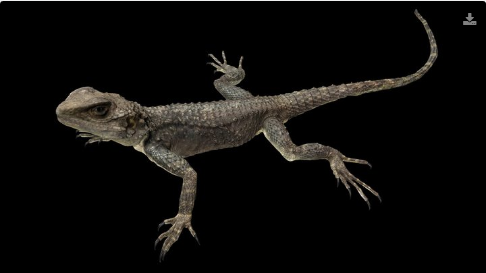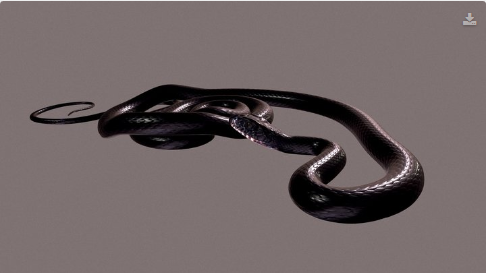
Sling tailed agama
Learn more about reptile



The Starred Agama is a very sturdy lizard, growing up to a total length of 380mm. It has flattened relatively short body and triangular head. The neck is well defined, and the legs are prominent. Noticeably spiny body with rows of tubercles on the back. The tail is stout, covered with rings of spiny scales. The body is blackish brown with a series of yellow blotches along the back and on the forelegs. Dark rhomboid patches are scattered on the back, particularly on the anterior part. The underside is creamy beige. Young specimens are similarly painted but their drawing is highly contrasted.


| Scientific name: | Stellagama stellio (Linnaeus, 1758) |
|---|---|
| Subspeciese: | Stellagama stellio cypriaca (Daan, 1967) |
| English common name: | Starred Agama |
| Greek common name: | Κουρκουτάς (Kurkutás) |
| Higher Taxa (Family): | Agamidae |
| Global distribution: | Greece, Turkey, Syria, Lebanon, Egypt, Iraq, Saudi Arabia, Cyprus, Jordan, Israel |
| Cyprus distribution: | Widespread. From sea level up to the highest peak of Troodos mountain (1.930m altitute) |
| Sexual dimorphism: | There is sex-specific difference due to the presence of callous glandular scales on males. Those scales are absent from female individuals. Additionally, the tail base of the males bears the hemipenes and is thus vaulted. |
| Ecology: | The Starred Agama inhabit a wide variety of habitats. It can be found in dry habitats on stone walls, rocks, beaches, habitats with bushes and shrubs, forests, and fields. It also lives in olive and carob trees as well as other hollow trees. It is a synanthropic species than can be found in cities climbing walls and living inside roofs of houses. |
| Diet: | The Starred Agama is mainly insectivorous feeding with a large variety of insect upon availability. It can also feed on small vertebrate (eg. young mice or sparrows) and plant material (eg. fruits, petals) |
| Reproduction: | Oviparous. Reproductive period starts early on spring. Lay clutches of 3-10 eggs. First clutches are laid in May and June. Two clutches are typically laid in a year. Eggs are deposits in rock gaps and holes. First hatchlings appear late August to early September. Exhibits temperature‐dependent sex determination. |
| Behaviour: | The Starred Agama is a great heliophile and thermophily lizard and can frequently be seen remaining active during the very hot midday hours basking on rocks. The Cyprus population seems to remain active throughout the year. The Starred Agamas is a very shy species and will quickly disappear into the nearest rock crevices if disturbed. When in open spaces, individuals sometimes raise themselves on the hindfeet and remain in this posture while running away. When on trees individuals will run up the trunk on the side opposite to the observer. The Starred Agamas is a highly social species. Intraspecific communications involve numerus characteristics movements such as the vertical bobbing of the head (head bobbing), a very commonly observe movement. Head bobbing seems to be a threatening posture against consexuals during territorial defence and a mating signal for attracting the opposite sex. |
| Gender: | Male |
|---|---|
| Age group: | Adult |
| Snout Vent Length (cm): | 10.7 |
| Tail size (cm): | 19.4 |
| Total size (cm): | 30.1 |
| Morphometric data (cm): | Body length:6.8; Forelimb to hindlimb distance: 4.2; Head length: 2.7; Head width: 2.8; Head depth: 1.8; Body width: 3.0; Pelvic width: 1.8; Tail width: 1.7; Pelvic height: 1.4; Humerus Length: 1.9; Ulna Length: 2.3; Forefoot Length: 1.6; Femur Length: 2.3; Tibia Length: 3.0; Hindfoot Length: 3.1 |
| Captured Location (name): | Parekklisia village, Limassol district, Cyprus |
| Captured date: | 14.04.2019 |
| IUCN Red list: | Least Concern (LC) |
|---|---|
| Habitat Directive (92/43/EC): | Annex IV |
| Bern Convention: | Annex II |
| National Legistlation 153(I) 2003: | Annex II |
| Endemisc: | Endemic subspecies of Cyprus |
The species is protected under the Annex IV or the Habitat directive 92/43/EEC, the Annex II of the Bern Convention and the Annex II of the Cyprus National Legislation 153(I)2003.
| Location of 3D Scanning: | Terra Cypria - The Cyprus Conservation Foundation, Limassol |
|---|---|
| Date of 3D Scanning: | 18.04.2019 |
| Location of Motion Capturing: | Terrestrial Ecosystem Management Lab, Open University of Cyprus, Latsia, Cyprus |
| Date of 3D Motion capturing: | 20-21.06.2019 |
The Large whip snake is probably the longest snake found in Europe, growing up to a total length of almost 3m. The pupils are round. Is a non-venomous snake and thus has aglyphous dentition. The species displays an ontogenetic colour change. During the first one and a half years, the snake has an olive-green colour with small brown flecks that cover about two thirds of the body. The underside of juveniles has an iridescent sheen. On reaching sexual maturity, the ground colour darkens and the patterns disappear. The snake gets a shiny blueish-black colour, with only the underside of the head being a whitish, yellowish to read colour. Usually, specimens of more that 1 m are exclusively black.


| Scientific name: | Dolichophis jugularis (Linnaeus, 1758) |
|---|---|
| Subspeciese: | Dolichophis jugularis jugularis (Linnaeus, 1758) |
| English common name: | Large whip snake, black snake |
| Greek common name: | Μαύρο φίδι (Mávro phídi), Θερκό (Therkó), Περβολάρις (Pervoláris) |
| Higher Taxa (Family): | Colubriadae |
| Global distribution: | Turkey , Greece, Cyprus, Israel, Syria, N Iraq, N Iran, Jordan, Lebanon, Kuwait |
| Cyprus distribution: | Widespread. From sea level up to 1.700m altitute |
| Sexual dimorphism: | There is a slight sex-specific difference especially in the number of subcaudals: males have 107 to 118 subcaudals, females 101 to 113. Additionally, the tail base of the males bears the hemipenes and is thus vaulted. Males sometimes have a rusty brown background colouration. |
| Ecology: | The Large whip snake is the most common of all snakes species in Cyprus. It is widespread and does not appear to need a particular habitat for survival. It has been observed in towns, gardens, fields, meadows, low and high shrubs, and in forests. It often hides under float stones, logs, shrub piles, rock piles, and stonewalls. |
| Diet: | Young individuals of the Large whip snake feeds on isects and small lizards. Adults prey on mice, rats, birds, lizards and other snakes. Cannibalism has been observed. |
| Reproduction: | Oviparous. Reproductive period starts early on spring. Lay clutches of 6-11 eggs early on summer (June/July). First hatchlings appear late August to early September. Exhibits temperature‐dependent sex determination. |
| Behaviour: | The Large whip snake is a strong, agile and fast-moving snake. Although it is normally found on the ground, it is an excellent climber and has been repeatedly observed climbing in trees and old houses in searching for food. Different types of hunting techniques have been observed depending on the type of pray (e.g. rodent, birds, snake, lizard). The species seems to remain active throughout the year (not hibernating) but reduce its activity during the cold period of the year. In captivity, these snakes usually get used to being handled through they are rather unpredictable, and may strike or bite at first. |
| Gender: | Male |
|---|---|
| Age group: | Adult |
| Snout Vent Length (cm): | 146.0 |
| Tail size (cm): | 43.0 |
| Total size (cm): | 189.0 |
| Morphometric data (cm): | Head width: 1.6; Head length -1: 1.7; Head length-2: 3.1; Head depth: 1.5; Circumference 10 cm: 5.2; Circumference 20 cm: 6.7; Circumference 30 cm: 7.6; Circumference 40 cm: 7.7; Circumference 50 cm: 7.7; Circumference 60 cm: 8.1; Circumference 70 cm: 8.7; Circumference 80 cm: 8.2; Circumference 90 cm: 7.5; Circumference 100 cm: 7.0; Circumference 110 cm: 6.8; Circumference 120 cm: 6.8; Circumference 130 cm: 6.8; Circumference 140 cm: 6.2; Circumference 150 cm: 4.8; Circumference 160 cm: 4.0; Circumference 170 cm: 3.2; Circumference 180 cm: 2.1; Depth 10 cm: 1.9; Depth 20 cm: 2.4; Depth 30 cm: 2.7; Depth 40 cm: 3.1; Depth 50 cm: 3.3; Depth 60 cm: 3.2; Depth 70 cm: 3.2; Depth 80 cm: 3.1; Depth 90 cm: 2.8; Depth 100 cm: 2.8; Depth 110 cm: 2.5; Depth 120 cm: 2.5; Depth 130 cm: 2.5; Depth 140 cm: 2.2; Depth 150 cm: 1.6; Depth 160 cm: 1.4; Depth 170 cm: 1.0; Depth 180 cm: 0.6 |
| Captured Location (name): | Kolossi village, Limassol district, Cyprus |
| Captured date: | 11.04.2019 |
| IUCN Red list: | Least Concern (LC) |
|---|---|
| Habitat Directive (92/43/EC): | Annex IV |
| Bern Convention: | Annex II |
| National Legistlation 153(I) 2003: | Annex II |
| Endemisc: | N/A |
The species is protected under the Annex IV or the Habitat directive 92/43/EEC, the Annex II of the Bern Convention and the Annex II of the Cyprus National Legislation 153(I)2003.
| Location of 3D Scanning: | Terra Cypria - The Cyprus Conservation Foundation, Limassol |
|---|---|
| Date of 3D Scanning: | 16.04.2019 |
| Location of Motion Capturing: | Computer Graphics Lab, University of Cyprus, Nicosia, Cyprus |
| Date of 3D Motion capturing: | 14-15.05.2019 |
Website template by Themefisher.com
Developed by Michael Konstantinou